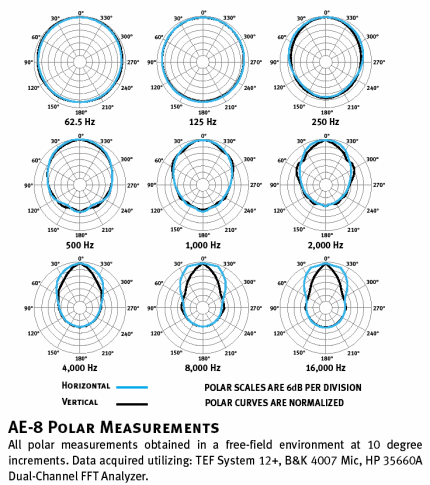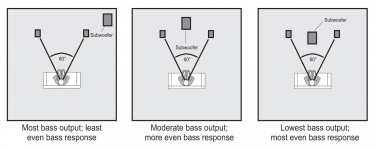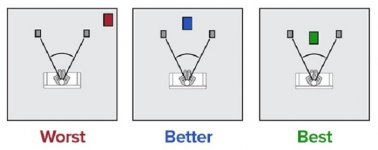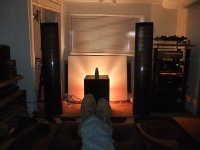Do your research, and hopefully you will soon realize that most of the articles and videos out there are catering to the home theater crowd or large stereo rooms (hence the multi-sub approach).
This means they are trying to get good bass almost everywhere when you are flying solo and only need it where your chair is at (the studio mixing room articles might actually be more applicable).
This is a HUGE difference, after all it's 2-channel stereo and not 5.1 or 7.1 HT with a dedicated channel already optimized.
However you can make it 2.1 with a rack mounted crossover after the preamp, I did not go that route.
Good news is some of the basic acoustic principals apply to your small room, a one or two person sweet-spot listening room.
So if you have one old sub, then you are in luck, I have a solution that just might work for you.
Using the KISS Method I'll start with some pictures (see below).
Video/article-1:
Ideal Subwoofer Placement & Pressurization – Acoustic Fields
White Paper:
Soundoctor - all about subs
Thread on subwoofer crossovers cause phase issues:
Subwoofers and Time Relationships | What's Best Audio and Video Forum. The Best High End Audio Forum on the planet!
Add it all up..........
1. Must get subwoofer away from walls.
2. Subs are more directional than advertised.
3. LP and CD bass is mono (recording engineer claimed so - read White Paper)
4. Try inverting/switching IC wires going to subwoofer.
5. Better to use Low Level inputs (interconnect cables) from dual output preamp than hooking up with speaker wires via High Level Inputs.
6. In all cases experiment and find what works for you, I only know what worked for me in my room - results may vary.
Picture of my dark room below, a work in progress.
What you see is the loudspeakers in typical position, with chair set back a little from sweet-spot just like dipoles are supposed to be, but the subwoofer is actually in a near-field listening position because bass wavelengths are so long. This is called a "pressure zone" listening position where you heard the sub first, and not the room.
My settings are near the minimal volume level, and crossover frequency also near the 37 Hz minimum.
The sound of a drum kit is dead center and at the proper height too.
The less junk you have between your speakers and on the front wall the better your sound-staging should be. My equipment rack on the right is scheduled to be moved out of there when I remove the closet wing-wall to the left. Then the speakers can be moved farther apart, and my seat set further back. I might have to adjust toe-in again at the same time.
It pained me at first to put the sub in the middle, but acoustics above convenience.
This means they are trying to get good bass almost everywhere when you are flying solo and only need it where your chair is at (the studio mixing room articles might actually be more applicable).
This is a HUGE difference, after all it's 2-channel stereo and not 5.1 or 7.1 HT with a dedicated channel already optimized.
However you can make it 2.1 with a rack mounted crossover after the preamp, I did not go that route.
Good news is some of the basic acoustic principals apply to your small room, a one or two person sweet-spot listening room.
So if you have one old sub, then you are in luck, I have a solution that just might work for you.
Using the KISS Method I'll start with some pictures (see below).
Video/article-1:
Ideal Subwoofer Placement & Pressurization – Acoustic Fields
White Paper:
Soundoctor - all about subs
Thread on subwoofer crossovers cause phase issues:
Subwoofers and Time Relationships | What's Best Audio and Video Forum. The Best High End Audio Forum on the planet!
Add it all up..........
1. Must get subwoofer away from walls.
2. Subs are more directional than advertised.
3. LP and CD bass is mono (recording engineer claimed so - read White Paper)
4. Try inverting/switching IC wires going to subwoofer.
5. Better to use Low Level inputs (interconnect cables) from dual output preamp than hooking up with speaker wires via High Level Inputs.
6. In all cases experiment and find what works for you, I only know what worked for me in my room - results may vary.
Picture of my dark room below, a work in progress.
What you see is the loudspeakers in typical position, with chair set back a little from sweet-spot just like dipoles are supposed to be, but the subwoofer is actually in a near-field listening position because bass wavelengths are so long. This is called a "pressure zone" listening position where you heard the sub first, and not the room.
My settings are near the minimal volume level, and crossover frequency also near the 37 Hz minimum.
The sound of a drum kit is dead center and at the proper height too.
The less junk you have between your speakers and on the front wall the better your sound-staging should be. My equipment rack on the right is scheduled to be moved out of there when I remove the closet wing-wall to the left. Then the speakers can be moved farther apart, and my seat set further back. I might have to adjust toe-in again at the same time.
It pained me at first to put the sub in the middle, but acoustics above convenience.
Attachments
Last edited:
One thing perhaps not made clear enough in the opening post is that the fewer things located in between the speakers (excluding subwoofer) the better, as anything in the middle will interfere with sound-staging.
Something in between the speakers like mono-amps on platforms or a low slung sub are less of a problem.
Items do not have to be at ear level to be of nuisance, the reason being that driver radiation patterns are not 2D FLAT as seen in polar radiation charts, the lobes are 3D.
This means the AIR adjacent, below and above the driver are part of the sonic presentation, and if you nibble into it, it's like a half eaten pie.
You want the WHOLE pie, don't you?
This phenomena may be more present in dipole and panel speaker than conventional dynamic drivers, and even less present in typical horn speakers, however it should not be ignored in any of them, in my opinion.
Radiation pattern varies with frequency (usually).
RealTraps - Front Wall Absorption

Move your audio rack off to a sidewall if you can (it's in my plans), and not at a first reflection point if you can help it.
Something in between the speakers like mono-amps on platforms or a low slung sub are less of a problem.
Items do not have to be at ear level to be of nuisance, the reason being that driver radiation patterns are not 2D FLAT as seen in polar radiation charts, the lobes are 3D.
This means the AIR adjacent, below and above the driver are part of the sonic presentation, and if you nibble into it, it's like a half eaten pie.
You want the WHOLE pie, don't you?
This phenomena may be more present in dipole and panel speaker than conventional dynamic drivers, and even less present in typical horn speakers, however it should not be ignored in any of them, in my opinion.
Radiation pattern varies with frequency (usually).
RealTraps - Front Wall Absorption

Move your audio rack off to a sidewall if you can (it's in my plans), and not at a first reflection point if you can help it.
UPDATE:
I have continued to work on my negative space or so-call free air space.
Removed wing wall on left, had to keep post for now.
Relocated equipment audio rack to side wall.
Removed second seat just last night.
Added side wall and ceiling diffusion.
Put carpet backing and felt cloth over top and sides of subwoofer.
Lots of other stuff all adding up bit by bit.
Will post images once I fix the power jack on my laptop, I'm on my cell phone now.
Moral of story: if you want a proper frontstage, unclutter it.
If you want bass in the middle, put your subwoofer there, I can localize bass by the pressure wave if nothing else. And there is always some little thing to give away location.
I have continued to work on my negative space or so-call free air space.
Removed wing wall on left, had to keep post for now.
Relocated equipment audio rack to side wall.
Removed second seat just last night.
Added side wall and ceiling diffusion.
Put carpet backing and felt cloth over top and sides of subwoofer.
Lots of other stuff all adding up bit by bit.
Will post images once I fix the power jack on my laptop, I'm on my cell phone now.
Moral of story: if you want a proper frontstage, unclutter it.
If you want bass in the middle, put your subwoofer there, I can localize bass by the pressure wave if nothing else. And there is always some little thing to give away location.
Last edited:
One thing perhaps not made clear enough in the opening post is that the fewer things located in between the speakers (excluding subwoofer) the better, as anything in the middle will interfere with sound-staging.
A sincere question ...
I've never really had a problem with the TV and equipment stand between the speakers, across several setups I've done. The "soundstage" we hear is something of an audio hallucination caused by sound from both speakers. Thus there really is no sound source (except the sub) between those speakers. So I do have to ask how much difference this makes...
Is this a minor or major consideration?
It can be advantageous to have a flat reflective "fairly large" area centered between the speakers. Speakers baffles in line or sligthly in front of that reflective area. (May help up the stereo image sound wise, instead of a diffuser "blurring the image" or an absorber which "kills" reflections (often) coming back towards the frontwall from the backwall.)
It can be advantageous to have a flat reflective "fairly large" area centered between the speakers. Speakers baffles in line or sligthly in front of that reflective area.
Interesting ... in most of my cases, that would be one huge TV set...
Thank you.
It can be advantageous to have a flat reflective "fairly large" area centered between the speakers. Speakers baffles in line or sligthly in front of that reflective area. (May help up the stereo image sound wise, instead of a diffuser "blurring the image" or an absorber which "kills" reflections (often) coming back towards the frontwall from the backwall.)
Nice Sarcasm!
Stuff between and behind the speakers is of foremost concern for dipole, panel, open baffle and 360 degree radiating speakers.A sincere question ...
I've never really had a problem with the TV and equipment stand between the speakers, across several setups I've done. The "soundstage" we hear is something of an audio hallucination caused by sound from both speakers. Thus there really is no sound source (except the sub) between those speakers. So I do have to ask how much difference this makes...
Is this a minor or major consideration?
Probably less of a concern for boxes, I mean conventional dynamic speakers, but I think they will like the extra breathing room as well.
I'm told that many horn speakers are not as sensitive to what is behind and maybe between, which is why you might see them in front of picture windows or other front wall backgrounds that would frustrate others.
My speakers or should I say my ears like a little absorbtion center-stage.
In days of large CRT screen TV's this was more of a problem. Both obstructive and reflective.
It is a lot of work to move your system around as I have several times since starting this thread. However should you visit any hi-end store selling systems that cost more than a fine automobile you will see similar unobstructed front fields.
- Home
- General Interest
- Room Acoustics & Mods
- Two Channel Stereo + subwoofer (small room)


